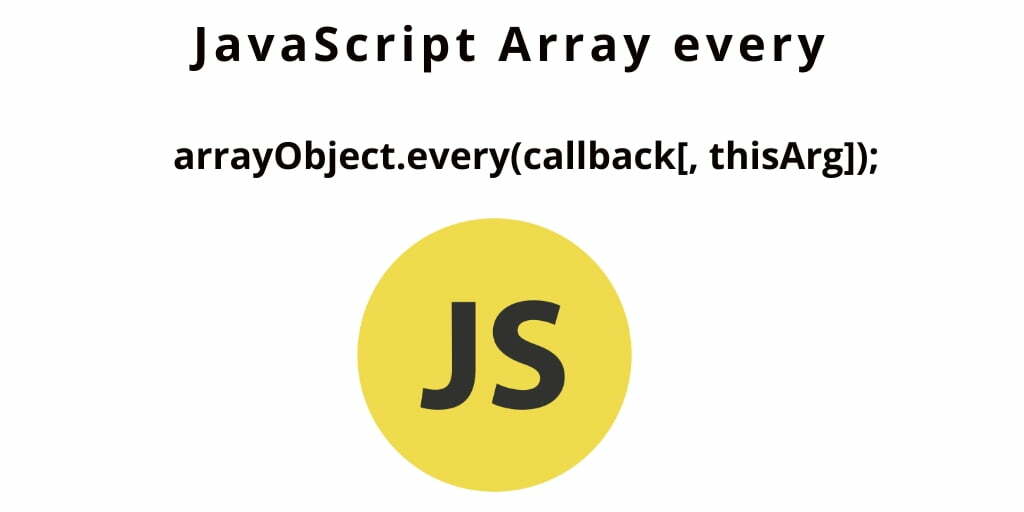JavaScript Array every method;In this tutorial, you will learn how to check whether all the given elements in an array are fulfilled the given test condition.
When you work with javascript arrays, so many times, you need to test whether all elements of an array and meet a specific test condition.
So in that case, you iterate all elements of an array using for loop and check the specific condition on each element of an array.
For example, you have numeric array, see the following:
let numbers = [1, 3, 5, 7, 9];
The following javascript code satisfies specific test condition on every element of a numeric array:
let numbers = [1, 3, 5, 7, 9];
let output = true;
for (let i = 0; i < numbers.length; i++) {
if (numbers[i] <= 0) {
output = false;
break;
}
}
console.log(output);
Output:
true
How it works:
- First of all, declare a numeric array with elements.
- Next, define the
outputvariable and assign value totrue. - After that, iterate for loop over all elements and check specific test condition on each element of an array using the if statement.
- If the specified test condition met true, the
outputvariable assing tofalseand terminate the for loop quickly using thebreakstatement. - Otherwise, the value of the
outputvariable will betrue.
- If the specified test condition met true, the
- Console.log() the
outputvariable.
JavaScript every() method that allows you to check each element of an array with specified a test condition in a more concise and more readable way.
JavaScript Array every() method
Javascript Array every() method, check whether all the array elements are fulfilled the given test condition. It returns true when each given array element fulfills the test condition, otherwise return false.
In ES5, JavaScript Array every() method, tests each element of array with specific test condition with function.
The following example of javascript every() method:
let numbers = [1, 3, 5, 7, 9];
let output = numbers.every(function (e) {
return e > 0;
});
console.log(output);
Output:
true
By using the JS ES6 arrow functions, the javascript code can be more concise and more readable:
let numbers = [3, 5, 9, 11, 15]; let result = numbers.every(e => e > 0); console.log(result); // true
Syntax of javascript every() method
The following represents the syntax of the every() method.
arrayObject.every(callback[, thisArg])
The every() method accepts two named parameters: callback and thisArg.
1) The callback parameter
The callback is a function that tests each element of the array.
See the following:
function callback(currentElement, index, array){
//...
}
The callback() function accepts 3 parameters:
- First, the
currentElementis the current element of a given array. - Second, the index is the index of the current element of a given array
- Third, the
arrayis the given array.
2) The thisArg parameter
The thisArg parameter of the every() method is optional. If you pass the thisArg parameter into the method. So inside this callback function will get the reference this .
The every() method returns true if the callback function returns a truthy value for each array element; otherwise, it returns false.
Note that the every() method executes the callback() function on every element in the array until it finds the one that causes the callback() return a falsy value.
Examples: JavaScript Array every() method
The following example checks whether all the array elements are even numbers in it:
let numbers = [3, 5, 9, 11, 15];
let isEven = numbers.every(function (e) {
return e % 2 == 0;
});
console.log(isEven);
Output:
false
The following example checks whether all the array elements are odd numbers in it:
let numbers = [3, 5, 9, 11, 15];
let isOdd = numbers.every(function (e) {
return Math.abs(e % 2) == 1;
});
console.log(isOdd);
Output:
true
If you use the every() method on an empty array, the method will always return true for any condition.
See the following example:
let num = [].every(e => e > 0); // any condition
console.log('num:', num);
Output:
num: true
Conclusion
In this tutorial, you have learned how to use the JavaScript Array every() method to checks whether each element of an array and test defined condition.
